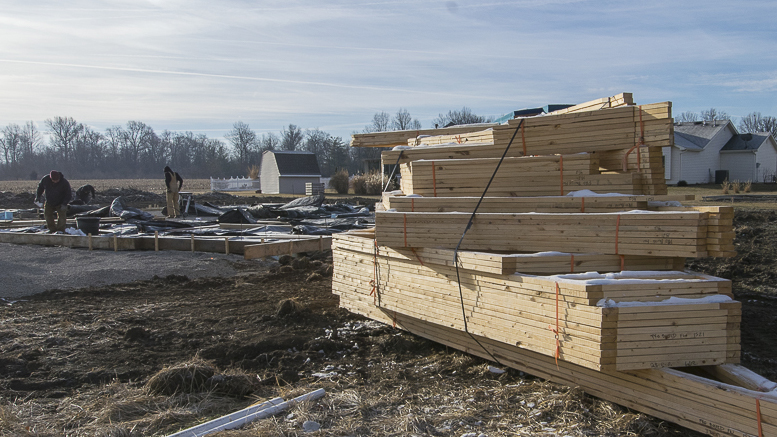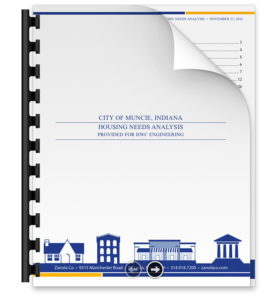By Mike Rhodes, Editor-in-Chief—
Muncie, IN—A housing needs analysis created for the City of Muncie has revealed a need for a total of 405 new homes with developed lots for nine specific housing types over the next five years. The housing types include urban attached, urban single family, suburb attached, suburb single family, and suburb custom homes. (See link to the entire study at the bottom of this article.)
The study was created by the Zanola Company, St. Louis, MO and MarketGraphics Research Group, Franklin, TN.
Research resources for the study included Delaware County Assessor data, Delaware County and City of Muncie Building Department data, U.S. Census data, Nielsen-Claritas research, Bureau of Labor and Statistics, Internal Revenue Service, and other resources currently available at the time of the study. The results of the study are below.
Muncie and Delaware County: Many Amenities
Communities in Muncie and Delaware County have several pre-existing amenities based on their location and the nature of the town. Since its founding in 1918 Ball State University has been a central part of Muncie’s identity and has established Muncie as a ‘college town’. For most of the year Muncie is home to a vibrant group of young students who make the city feel livelier than comparable towns without a large college. Ball State also offers the community a plethora of cultural, sporting and entertainment events that are open to the public.
Muncie also has a nationally recognized regional health center in IU Health/Ball Memorial Hospital, and Delaware County Schools were ranked highly by US News and World Report. There are numerous parks within Delaware County including Prairie Creek Reservoir. Muncie has a variety of national chain and local retail stores with the major commercial drive being McGalliard Road which offers a wide range of retail, dining, and entertainment.
Downtown Muncie has benefitted from a wide range of community revitalization efforts and new construction and businesses. The recently constructed Courtyard Marriott Muncie adjacent to The Horizon Convention Center has supplemented other downtown renovation projects, creating a lively city center along Walnut Street. In addition, Muncie’s strong philanthropic organizations such as the Ball Brothers Foundation and Community Foundation of Muncie and Delaware County pump millions of dollars into the area to improve education, economic development and quality of place in Muncie and Delaware County.
Muncie has been very active in developing a network of biking and walking trails through Cardinal Greenways to promote healthy living, and there are plans to expand one of these trails southwest to Anderson, Indiana, and from there potentially to Indianapolis.
However, There’s a Lack of Desired Housing Inventory
At a November 2017 meeting of the Muncie Redevelopment Commission, the Muncie Downtown Development Partnership indicated the average age of a downtown resident was 33 years old. However, older people who want to downsize are also interested in living in downtown Muncie. Occupancy rate for available downtown living spaces was at 99% with a waiting list for downtown housing. MDDP indicated vacancies typically only last for 72 hours or less.
Last year at the 6th Annual State of Commercial Real Estate presented by Coldwell Banker Lunsford, housing inventory was on the list of topics. At that time, Mike Lunsford said, “In the residential housing market, there is a lack of inventory. This continues to be a major problem. Without any new construction adding to inventory, availability of homes will be a significant challenge in 2017. People coming here to work who cannot find housing they like, will commute from other areas. Lack of inventory here will drive prices higher. In 2016, the average sale price of a home had increased 4-6%. Residential homes with a selling price of $100-$150k, are only on the market an average of 2.1 months. Homes from $250-$300k are only the market an average of 3.6 months.
“Delaware County desperately needs new home construction,” said Lunsford.
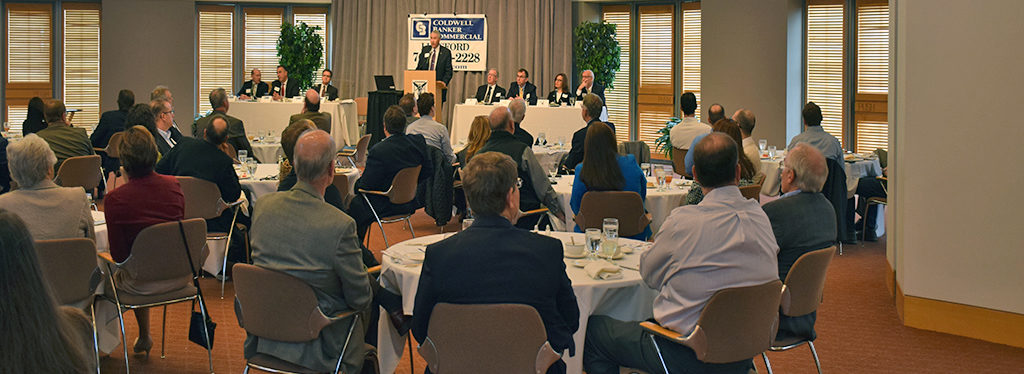
6th Annual State of Commercial and Residential Real Estate, held February 22, 2017. Photo by: Mike Rhodes
The Zanola study also indicates that there is a lack of inventory in Muncie and Delaware County and that prospective home buyers who work here often must find desirable homes elsewhere. The study indicates that low rates of new homebuilding between 1990 and present has resulted in a generally aging of total home supply. Without increased new homes creation, existing home obsolescence results in a net loss of available housing units.
New home permits appear very limited and at the present moment not adequate to support household growth as well as counter obsolescence of aging, existing homes.
For example, there were 123 new home permits in the City of Muncie from 2014 through October 2016. Permits greatly vary annually from 86 in 2014, to only 5 the following year in 2015. There were 32 permits issued for new home construction during the first ten months of 2016.
There were a total of 59 new home permits in Delaware County from 2014 through October 2016. County permits were more consistent than Muncie over the previous two years with 14 in 2014 and 15 in 2015. The study indicated there were 30 permits issued for new home construction in the county during the first ten months of 2016.

Building Permits for home construction in Muncie and Delaware County. Zanola Company and MarketGraphics Research Group.
The local governments of Muncie and Delaware County are actively seeking to refresh their housing market and reverse the recent trend of sagging population. Long-term strategies such as the Muncie Action Plan seek to capitalize on Muncie’s atmosphere to attract new residents and construction without losing the city’s current charms. Downtown revitalization efforts, new outdoor community attractions, and guidelines for how new housing will connect with existing neighborhoods provide a good foundation for future residential expansion in Muncie.
New Home Purchasing Age Groups
Age groups are listed below for Muncie, Indiana, and Delaware County.
The highlighted age groups generally represent the top targets for new, for sale housing in the Muncie market. Over the next five years the Census is projecting large increases by percentage of population in Muncie and Delaware County in the ranges of 25 to 35 and 65 to 74 mostly due to the aging of current residents.
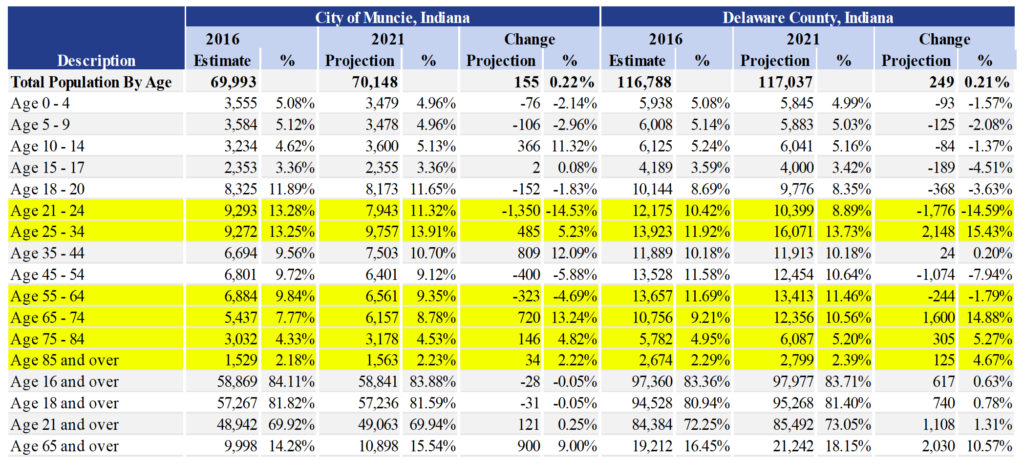
Population By Age Trends-Top Targets for new housing. Zanola Company and MarketGraphics Research Group.
Household Income and Ability to Purchase
The study indicated using household income of $50,000 and greater as a general target for Muncie residents able to buy new homes, approximately 29 percent of City of Muncie households and 38 percent of Delaware County households can be considered income-qualified. Often a higher income homebuyer is targeted for this type of study. However, in Muncie this study is identifying $50,000 to accommodate existing lower income households as well as younger first time home-buying households choosing to remain in or move to Muncie.
The average household income in the city of Muncie is estimated to be $43,725 for the current year. The average household income of Muncie is projected to increase significantly over the next five years, from $43,725 to $47,872, a change of 9.48 percent.
The average household income in Delaware County is estimated to be $52,682 for the current year. The average household income in Delaware County is projected to change over the next five years, from $52,682 to $56,853, a change of 7.91 percent.
The average household income for the United States is estimated to be $74,165.
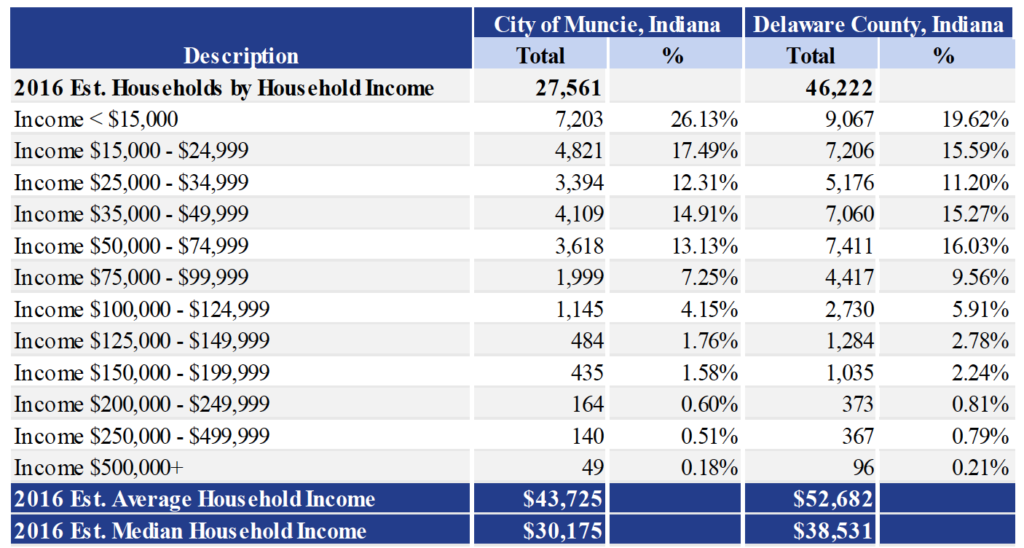
2016 Est. Households by Household Income. Zanola Company and MarketGraphics Research Group.
Institutional and Business Housing Information Commentary
The study included interviews with local Ball State University and Ball Memorial Hospital Executives. Some of their comments are below.
The housing stock older than five years is really, really dated.
Faculty wants granite, updated baths, and hardwood floors. Homes that are low maintenance and ready for two professionals that aren’t “maintenance people.”
Younger faculty see the value in the housing in Muncie and have a more local mindset.
Upwards of 40 percent of the faculty live outside of Delaware County.
We need a “if you build it, they will come” mentality – the effect can only be positive and keep moving the needle up.
K-12 schools in Muncie get an unfair bad rap. The quality of the schools is quite good, but that isn’t marketed. A more proactive approach is needed.
Housing needs to be ready. Interviews take place in the spring, job offers in May, and they must be ready for school to start in August. So walking in to housing that’s available and updated is important.
Faculty trying to find homes 2,200-2,500 square feet have a lack of inventory to choose from, however, what they do have is a great value for the square footage.
Proximity to the university, shorter commutes, and connecting work directly to Muncie community can all attract employees to the Muncie area.
People understand that Muncie is a good place to live and they have a good mayor that embraces diversity.
New physicians are offered incentives to live in Delaware County.
Suggestions for new housing – mid-income housing and starter homes are needed; downtown housing; Millennial housing in the $40-50k salary range.
You can buy a very nice, decent square footage house in Muncie for a good value when it’s available.
Zanola Company Study Strategies and Recommendations
Strategies – Muncie’s concluded key strategies for new homebuilding are presented below.
• Strategy Promoting Muncie – Build on Muncie’s strong branding and marketing identity to include attracting residential development and new homebuilding.
• Strategy Growing Muncie – Approach need for additional new homes as tremendous strategic opportunity for Muncie’s growth as a welcoming community building lifestyle communities.
• Strategy Residential Development Parity – Approach encouraging residential growth with parity to other economic development strategies and incentives. A new reality is emerging that community’s residential development and new homes creation may often require spurring and supporting at same levels accustomed for other economic growth areas.
• Strategy Existing and New Residents – Direct and balance new home growth opportunities for both sustaining existing Muncie residents as well as attracting new residents to Muncie.
• Strategy Economic and Homebuilding Vibrancy – Align new housing growth and vibrancy directly with total successful economic development, jobs growth, and sustainable attraction to Muncie. (Whether apparent currently, proving new home availability may have limited Muncie from being chosen for company expansions and relocations.)
Recommendations – Muncie’s concluded key recommendations for new homebuilding are presented below.
• Recommendation Existing Residents – For sustaining residents, focuses are recommended to increase share of owner occupied housing as well as provide lifelong home choices as household needs change.
• Recommendation New Residents – For attracting new residents, focuses are recommended to generally target younger age groups establishing first households plus 50+ age groups making a lifestyle choice for where to live next.
• Recommendation Common Households Synergies – Both the younger age groups and the 50+ age households are expected to have many common synergies and expectations related to choosing where to live and new home types. It is recommended to maximize these commonalties by programming new neighborhoods and home types to suit both age groups and to enhance their desirability to live in same neighborhoods.
• Recommendation Suburban and Urban – Both the younger age groups and the 50+ age households are expected to be more open minded than in past for choosing neighborhood location and home type. It is recommended to maximize these neighborhood and home choices by offering balance of suburban oriented neighborhoods as well as close-in urban neighborhoods. This provides a broad range of home choices allowing the decision to become where to live in Muncie, instead of limited choices in Muncie. This range of new home choices is further expected to accommodate households’ future moving choices within Muncie.
Recommendation Adding Builder Capacity – For Muncie’s successful new homes expansion it is recommended to balance fostering local builders’ growth as well as attracting new builders to Muncie.
• Recommendation New Muncie Builders – Notably for new builders it is strongly recommended to target new builders (not recently building in Muncie) that commit to delivering specifically identified needed housing. It is further recommended to be cautious about builders more focused on simply transferring home types and plans from other communities.
• Recommendation Existing Muncie Builders – Notably for existing Muncie builders it is important to recognize that the lack of Muncie building vibrancy may limit local builders’ opportunities outlook. It is recommended to offer support and education for local builders marketing, sales, and production expertise to fulfill buyers’ future expectations and to increase capacity. It is further recommended to recognize area homebuilders for their quality, historical service for community, and other attributes prior to targeting new builders to move to Muncie.
• Recommendation Adding Suppliers, Trades, and Labor Capacity – For supporting building capacity, it is recommended (similarly to builders) to balance fostering local building resources growth with attracting new suppliers, trades, and labor sources to Muncie. Among builders’ greatest concerns for builders’ market entry are often resources, i.e. securing subcontractors and suppliers that may be loyal to existing builders and/or at capacity.
• Recommendation Improving Existing Homes and Values – For successful new homes growth it is strongly recommended to equally support and encourage value adding improvements to existing homes.
• Recommendation Realtor, Appraiser, and Influencer Education – For proactively leading new homes awareness, it is recommended to provide education (online and seminar formats) for Realtors, appraisers, and other key real estate influencers.
• Recommendation Continuing Resources – Providing ongoing real time resources is recommended to reinforce education, brand Muncie’s housing growth, and deliver Muncie’s new homes research results. There are five main strategies that combine to identify, appeal to, and connect with the homebuilders, developers, Realtors, and appraisers that are the best fit for Muncie.
—Prove the Opportunity – This research, condensed and repackaged to present opportunity highlights, is a credible insight into Muncie’s homebuilding needs. A strategy is to provide developers, homebuilders, and lenders an objective resource to analyze their opportunities.
—Best Candidates to Target – The scale of homebuilding needs allows defining the best type of developers and homebuilders for Muncie. A strategy is to identify and qualify the builders within a 250 mile radius of Muncie that fit the best builder and developer type.
—Open for Homebuilding Business – Evaluating permit, inspections, fees, and other direct City to builder issues are important to a builder’s first impression. Special programs, incentives, zoning, etc. may be the next level of inquiry. Banking, title companies, suppliers, etc. that are poised and ready to support homebuilding become a bonus. A strategy to prove that Muncie is open for homebuilding business by anticipating and preparing information and support that will be important to builder’s business decisions.
—Bolster Total Growth – Additionally strengthen the appeal to homebuilders with ongoing communication of economic and population growth efforts and also with economic development and homebuilder brand partnership opportunities.
—Ambassador Program – Establish an informed and enthusiastic group of ambassadors within local businesses including Ball Memorial Hospital, Ball State University, and other key community boosters. Special materials providing quick housing resources and data for use in recruiting qualified staff.
—Recommendation Outreach for Growth – For directly and quickly connecting with new households, it is recommended to provide invitational Move-to-Muncie hospitality and seminars. These are recommended to target both younger and older move-in target segments.
Segment Focuses – Muncie’s concluded segment focuses for new homebuilding are presented below.
• Segment Housing All Muncie Households – Focusing on all Muncie housing needs is critical. The present and potential demand compared to stable yet aging housing stock creates an All Muncie Households segment. It is importantly notable that sustaining and attracting Muncie households go hand-in-hand related to housing creation. While sustaining and attracting new households are organically linked at The Muncie Segment, for the purposes of this study housing needs focuses are expressed in three target segments.
• Segment Attracting Younger Households – This target segment concentrates on youthful vitality, entrepreneurship, lifestyles, and more that are typically associated with a positive university and small community environment. This target segment includes retaining those associated with the university as well as attracting new households because of the positive environment and expected opportunities.
• Segment Attracting Older Households – This target segment concentrates on maturing households (with and without children at home) that have common attractions as above younger households. This target segment includes attracting those with prior association with the university as well as attracting new households because of the comparatively superior environment, neighborhoods, and housing choices.
• Segment Sustaining All Households – This target segment concentrates on households living in Muncie that are presently held back from their next housing move, at risk of current housing obsolescence, limited to declining housing choices and higher housing expenses, and/or potentially facing decision to move away from Muncie.
Findings –Study findings reveal need for nine specific housing types over the next five years. In summary these include: urban attached, urban single family, suburb attached, suburb single family, and suburb custom homes.
—Forecast need for a total of 405 new homes with developed lots over the next five years for the city of Muncie, Indiana.
—Home prices range from $105,000 to $550,000.
— Lot prices range from $40,000 – $90,000.
—Total lot sales are forecast at $23,200,000 over the next five years.
— Total home sales are forecast at $97,860,000 over the next five years.
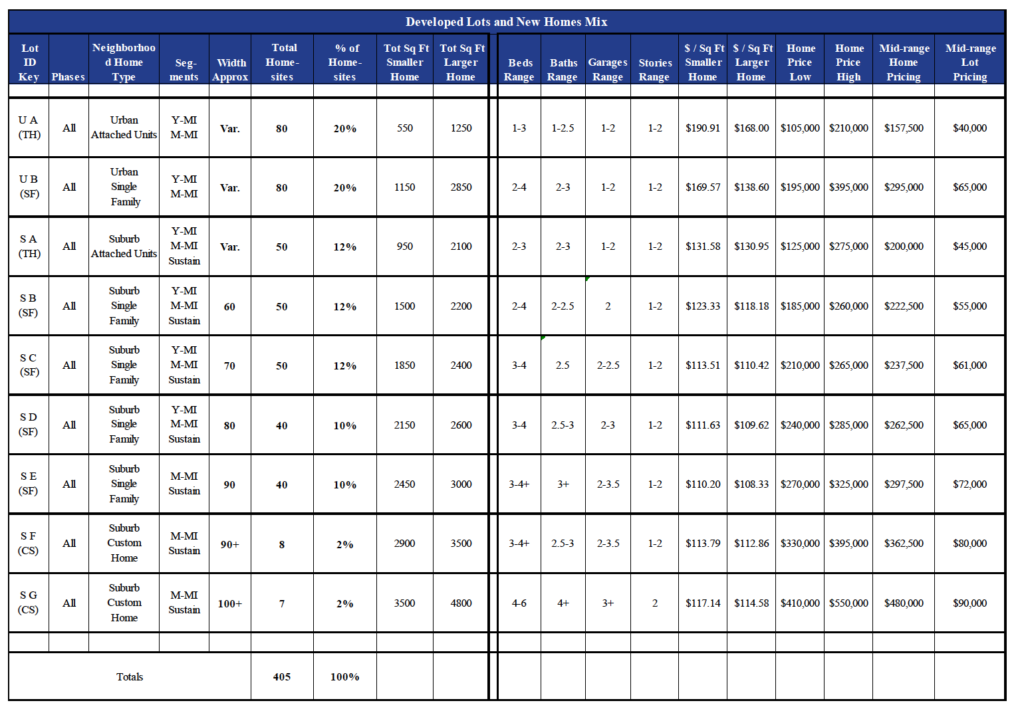
New Homes—Absorption and Revenues Forecast. Zanola Company and MarketGraphics Research Group. Click image for larger view.
Click the image above to view the entire study in PDF format.
About Zanola Company and MarketGraphics Research Group
Zanola Company is a nationally trusted partner in real estate research and development consulting, including MarketGraphics Research Group, Inc. research, opportunity discoveries, feasibility studies, marketing programs, sales management, and total business development.
Financial institutions, civic leaders, developers, builders, planners, investment groups, governments, and executives rely on Zanola Company for real-world market research, analysis, forecasting, and organizational guidance.

